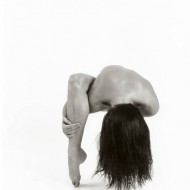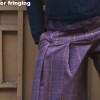It’s been some months since I started thinking about a new category of articles for Camera Obscura, something like “around a photograph”. A category with a series of articles, each one dedicated to an image, a particular picture, which came into my life and there it stayed, such a rock in the middle of a street. One of that pictures that astonishes, that leaves you dumbfounded. It could be love, repulsion, impression and envy, no matter what. They will be with me for the rest of my life, with their emotional and visual strength, never leaving me. I’m talking about rare images, pictures that become rarer and rarer the more boredom and knowledge pollute the astonishment on which we are looking at the world.
Some months ago I went visiting the gallery Baudoin-Lebon for the exhibition of Joel-Peter Witkin. Actually I already knew his work quite well, but I was always interdicted, as I didn’t know what to do. I’m fascinated, but I don’t know if the feeling is repulsion or love, or even both. I will not quote his images, which are famous, and I will not repeat the motivations behind his photography, the macabre biographical anecdotes that have been already largely discussed. I will focus on the picture: Ars Moriendi.
I fell in love at first sight. The cleanness of the composition, the antique and decadent languid pose, the macabre human corpses but most of all the strident counter position between the white body of the girl and the black heads of the corpses at her feet.
This is surely the first and strongest impression. The naked body is so plenty of life, so real that could come out of the picture, could be a girl leaning in front of you. Skin wrinkles, on the side, make her real beauty, every day beauty. Concrete beauty, not one of the doll we’re used to, a beauty with abounding breast, just falling, the young skin that will get old soon. An antique beauty, fleshy, rounded arms, large hips and thighs. Her whiteness of skin, the mortal pallor exalts her life murmur. This beauty watch us with sadness and melancholy, a young face that is starting fading, her eyes were tormented from who knows which kind of thin pain. White gloves, the mirror, the luxury of the gesture, of that hand with the feather underline the aristocratic nobility, the outmode decadence.
It could be an antique picture, a wonderful demoiselle fin de siècle, that could pose for a picture that is a hymn to beauty, to nakedness, to eroticism. If it wasn’t for the bodies lying at her feet. If it wasn’t for those old man heads, the face warped by death and putrefaction, the wide open dumb mouth with a few staggering teeth, the flaccid and falling skin, the sunken eyes, lock of hair pasted to skin with weird slurries.
The contrast is strong, but it’s contained in the image with extraordinary unity. The naked girl, with her long white feather, seems waving the decapitated bodies, as they would be idols to venerate, divinities to whom offer her life in sacrifice, as death would be the maximum authority to pay respect to. At the same time, the screaming and cut-off heads, at maiden’s feet, seem to venerate her life, they seem to sing a spring hymn, they look like a macabre offer to beauty and youth, they seem a crazy token of love, an extreme love.
Generally, in front of Wiktin images, mostly in still life (and this is absolutely still), composed with pieces of corpses, I never know if I’m stricken by a macabre curiosity. The possibility to finally see what society hides in every way, the real face of death, the putrefaction and the horror of time passing by closing the curtains of life. This surely happens with bodies photographed by Andres Serrano, who –even if I regard with esteem this artist for many other works- creates the 90% of his images satisfying this morbid curiosity. In the case of Witkin’s picture Ars Moriendi, I’d say that the presence of those horrifying heads is absolutely functional to the image.
I don’t want to find a rational message perforce, but in front of this image I’m dreadfully in the middle, it runs into me and I can’t go out uninjured. I can’t perceive this infinite mixture of life and death, beauty and horror, attraction and repulsion, eroticism and disgust. While I’m looking and looking again this terrible and magnificent image, I hear the echo of the poetry Une carogne, by Charles Baudelaire, that i post here in the article.
Poetry that says everything I haven’t said yet about this picture of Wiktin.
A carcass
Charles Baudelaire – Spleen et Idéal, XXIX
My love, do you recall the object which we saw,
That fair, sweet, summer morn!
At a turn in the path a foul carcass
On a gravel strewn bed,Its legs raised in the air, like a lustful woman,
Burning and dripping with poisons,
Displayed in a shameless, nonchalant way
Its belly, swollen with gases.The sun shone down upon that putrescence,
As if to roast it to a turn,
And to give back a hundredfold to great Nature
The elements she had combined;And the sky was watching that superb cadaver
Blossom like a flower.
So frightful was the stench that you believed
You’d faint away upon the grass.The blow-flies were buzzing round that putrid belly,
From which came forth black battalions
Of maggots, which oozed out like a heavy liquid
All along those living tatters.All this was descending and rising like a wave,
Or poured out with a crackling sound;
One would have said the body, swollen with a vague breath,
Lived by multiplication.And this world gave forth singular music,
Like running water or the wind,
Or the grain that winnowers with a rhythmic motion
Shake in their winnowing baskets.The forms disappeared and were no more than a dream,
A sketch that slowly falls
Upon the forgotten canvas, that the artist
Completes from memory alone.Crouched behind the boulders, an anxious dog
Watched us with angry eye,
Waiting for the moment to take back from the carcass
The morsel he had left.— And yet you will be like this corruption,
Like this horrible infection,
Star of my eyes, sunlight of my being,
You, my angel and my passion!Yes! thus will you be, queen of the Graces,
After the last sacraments,
When you go beneath grass and luxuriant flowers,
To molder among the bones of the dead.Then, O my beauty! say to the worms who will
Devour you with kisses,
That I have kept the form and the divine essence
Of my decomposed love!



































La modella del quadro e’ italiana ed era presente all’ inagurazione della mostra su witkin a Milano il 27 2 2008; dovrebbe esser credo la moglie di Composti
Ciao Joel,
grazie per l’informazione. Ce la fai a darmi qualche dettaglio aggiuntivo? Se magari hai il programma della mostra col nome della modella (o di Composti) me lo potresti mandare? Mi piacerebbe molto contattarla.
Ciao e Grazie
f
You can also subscribe to this post comments RSS feed.